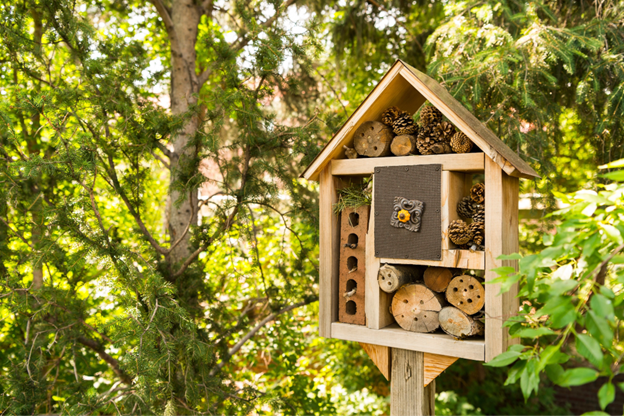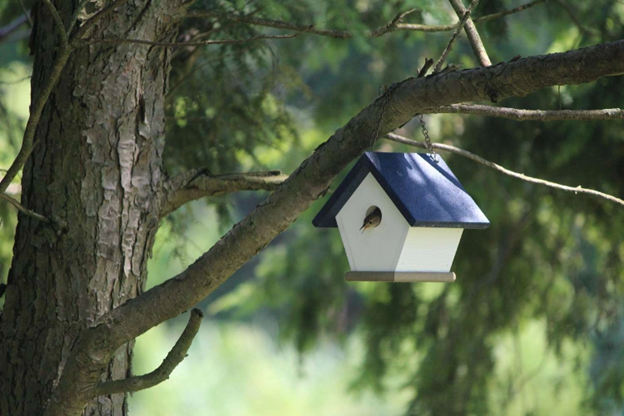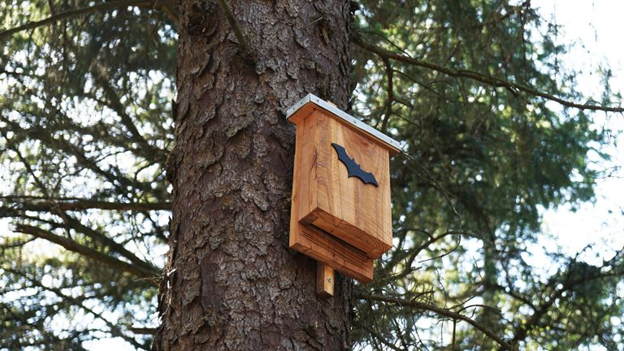Spring welcomes the return of many different species of birds, small mammals and beneficial insects. As the warm weather continues, local wildlife will be looking to nest in any available space. What is a better space than a tree? Trees provide wildlife with shelter, food and protection to raise young. Beneficial insects will flock to the trees to sip nectar or catch prey. Watching local wildlife in your backyard is an entertaining pastime, as well as an educational glimpse into how British Columbia’s fauna adapts to their changing environments. In this blog, we will go over tips on how to welcome local wildlife to visit your yard and make themselves at home.
Put up a Bee Hotel

There are several species of solitary bees across British Columbia, including the beloved Mason Bee. Solitary bees are beneficial pollinators and a part of the Okanagan microsystem. Solitary bees will look for places to nest where they will be provided shelter and protection from the rain. Bee hotels are a great way to support these local pollinators. You can create your own DIY bee hotel or purchase one locally.
When making a DIY bee house, the shape of a classic birdhouse is usually suitable. Instead of a box, though, you’ll fill in space with materials that provide tunnels for the bees to move into. Use blocks of wood and drill a variety of different-sized holes through the blocks, or make bundles of bamboo canes and fill the space in with those.
During the summer, bee houses should be positioned about 3 feet off the ground in full sun. Solitary bees are coldblooded and rely on the heat of the sun to warm them up. In the winter, they should be stored somewhere cold but dry. They need to be cold for the dormant bees to hibernate properly, and it’s crucial that they stay dry.
Mount Nesting Boxes

Several species of birds in the Okanagan have adapted to living alongside humans. Birdwatchers both old and new can set up a birdhouse in their trees that can become the home of robins, flycatchers and nutcrackers, and many other species of bird.
There are two types of homes you can add to your tree: nesting boxes and birdhouses. Nesting boxes are preferred as they can be mounted to the trunk of your tree, and they provide safe nesting habitat for birds that they will return to annually. Birdhouses tend to be more decorative than practical, and birds will generally not return after the season. Nesting boxes, depending on the size, can fit large nests or hatchlings.
It’s important to keep the location of your box in mind. Place the nesting box in a stable spot that is accessible to birds, but not to predators. Hygiene should be a priority when creating your nesting box. If you keep your nesting box clean after each season, birds are more likely to return. It also helps reduce the chance of predation. Thoroughly disinfect the box between nesting seasons after the birds have left. While wearing gloves and a mask, remove the old nest as carefully as possible and scrub the inside with a stiff-bristled brush.
Add a Bat Box

Bat boxes are a lot like nesting boxes as they both aim to create safe spaces to rest and raise young. Bat boxes provide the 14 species of Okanagan bats with a safe resting place, giving you the chance to see these private creatures in action during the evening and night. Bats are incredibly beneficial, as the ones located in the Valley are all exclusively insect eaters. They are especially good for those who own fruit trees. Codling moths are a huge problem for apple orchardists, but they are an appetizing meal for bats.
Bat boxes are most successful when installed for a colony of bats, keeping your home free of their roost. The BC Community Bat Program has designs and local places to purchase bat boxes for your outdoor space.
Bat houses should be placed as high as possible south or southeast-facing to ensure high solar exposure. Ideally, bat-houses should receive at least 10 hours of sun per day, and more is better unless you are in the hotter parts of the Okanagan. Try to find a position that will receive the morning sun and will not be shaded during the day. In an uncluttered location that does not have branches, buildings, or poles in front of it. If the bat-house is being placed on a tree, delimb any branches below the bat-house to reduce clutter.
You can mount a bat house at any time of the year. To help protect the house from predators, a slippery sheet-metal guard can be wrapped on the bottom of your tree to deter predators at these sites and mount at least 8 meters from the nearest tree branches. To reduce the chance of wasps taking advantage of the box, limiting the width of chambers to three-quarters of an inch helps keep them away. During winter months when bats are absent (November to March), check the bat house and remove any accumulated wasp nests.
Whether ornamental or fruit, trees provide shelter, food and protection for many species of local wildlife. Take care of your trees so that they can keep supporting the beneficial wildlife that shares our outdoor spaces.
Take Care of Your Trees

Arcadia Tree & Lawn Care helps businesses and residential clients manage the upkeep of their ornamental and fruit trees and lawn through customizable programs. From pruning, to spraying, to fertilization, we help keep Okanagan properties looking their best. Contact us today for a custom quote that will address the specific needs of your greenery.
